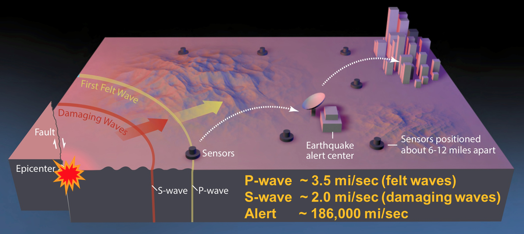Earthquake Alert App
-- posted March 2019 --
A phone app that sends earthquake warnings, ShakeAlert, became publicly available in California on January 1, 2019. The app was developed by the US Geological Survey.
The early warning system is based on a collection of over 800 sensors placed in California and along the West Coast. The sensors detect primary seismic waves created by earthquakes. The primary seismic waves travel faster than the secondary seismic waves, which cause the most damage. When a primary wave with a substantial intensity is detected by the collection of sensors (currently set at magnitude 5.0 or greater), the app sends an alert to the users’ cell phone in the form of a text message accompanied by a loud horn sound. The message provides information of the expected location, severity, and the time of occurrence of the impending earthquake. Because the transmission of communication signals is faster than the travel of seismic waves through the ground, the users have several seconds to find a cover and prepare for the earthquake.

Image source: https://www.shakealert.org/
The interval of time between detecting the primary seismic waves, sending the notification, and the actual shaking arriving, depends on the distance of the user from the epicenter of the earthquake. If the user is very close to the epicenter, the app will not be of much help. However, if the user is several hundred miles far from the epicenter, s/he may have between several seconds and several minutes before the shaking occurs.
Although several seconds does not sound like a long time, it can still make a big difference. For instance, it may be sufficient to stop public transport systems (e.g., subway trains) and prevent derailment, turn off electricity to prevent fires, close gas lines to avoid leakage, prevent vehicles from entering bridges or tunnels, shut down industrial systems, and take other similar actions.
One anticipated limitation of the app is that it will produce missed warnings and false alarms. For instance, shaking caused by non-seismic events in the immediate vicinity of a sensory station, or various signal processing errors, may produce false alarms. If the users run for cover several times and nothing happens, they may decide to ignore the warning when the big one hits.
Similar alert systems already exist in Japan, Mexico, and other regions that are particularly seismically active. A great majority of surveyed users in those countries approve of the technology, and most people stated that they prefer to receive false alarms rather than to feel the ground shaking without a warning.
Until we invent efficient ways to predict the occurrence of earthquakes, similar mobile apps can be very useful and contribute toward improved safety and reduced injuries and damage.
A short 1:38 minute video with a brief description of the app can be found here:
https://www.youtube.com/watch?v=XbWJSJuMVVc
